And Long-billed Curlews have now arrived in good numbers on Antelope Island.
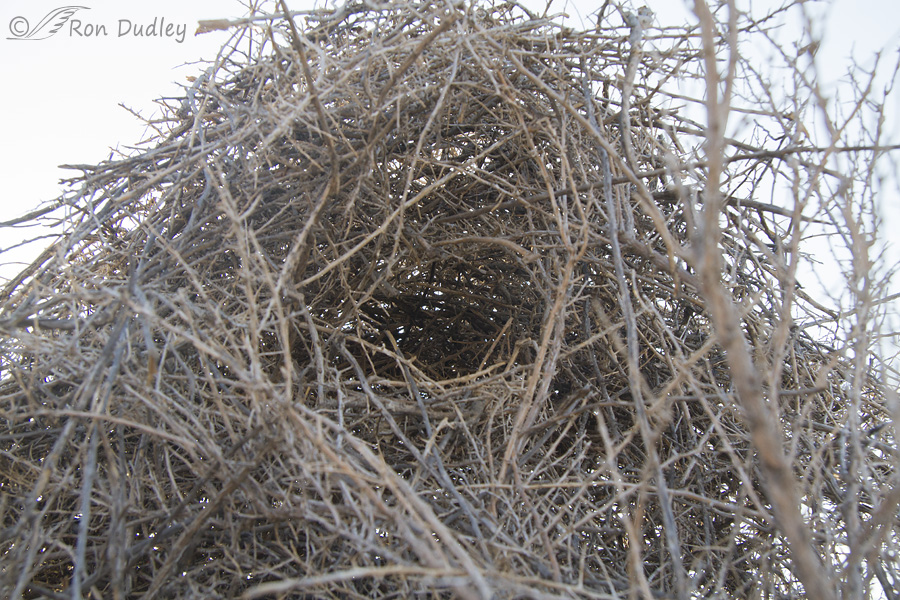
Magpie nests are typically durable domed structures made of sticks with an interior mud cup or bowl lined with grass. This photo of a magpie nest on Antelope Island was taken (in poor light) later in the year after nesting season was over and all the leaves had fallen from the greasewood bush the nest was built in. Here we’re looking upward toward one of the entrances to the interior of the nest.
Most construction takes place in the mornings with the male bringing in most of the larger sticks while the female contributes smaller sticks, the mud for the interior bowl and the grass lining. Well-constructed nests can take as long as three months to complete which explains why magpies may begin construction as early as January.
I’ve often photographed magpies bringing nesting materials (sticks, mud and grass) to the nest but the actual gathering of the mud has always eluded my photography because they gather it from random, muddy places that are usually much too far away even for documentary photos. But recent rains have produced mud puddles all over the island and yesterday morning I got lucky with the mud-gathering process.
None of my photos from yesterday were great shots but some of them are the best documentation of mud gathering I’ve been able to get to date.
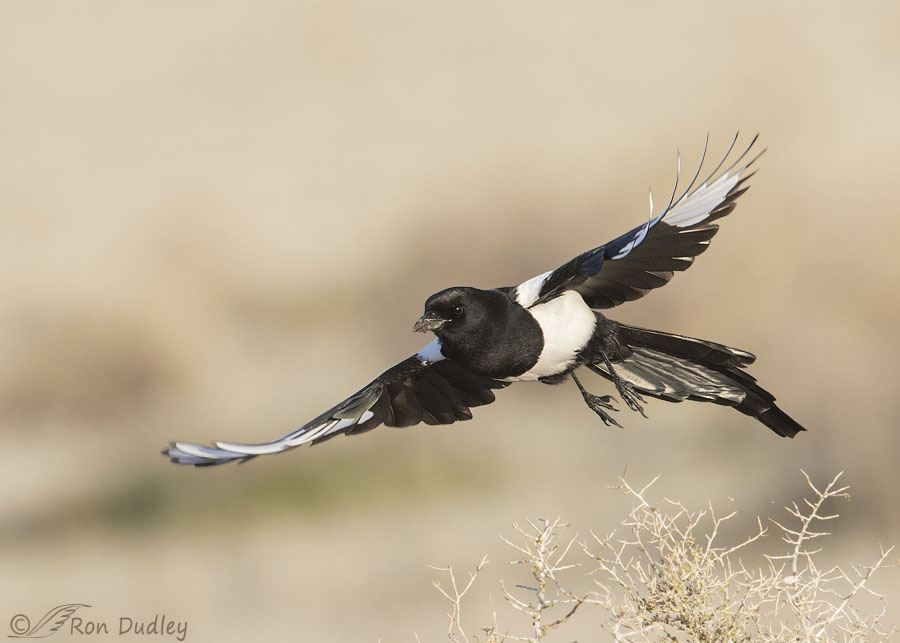
There were several magpie nests under construction in the general area and many of the magpies I saw had muddy bills, including this one.
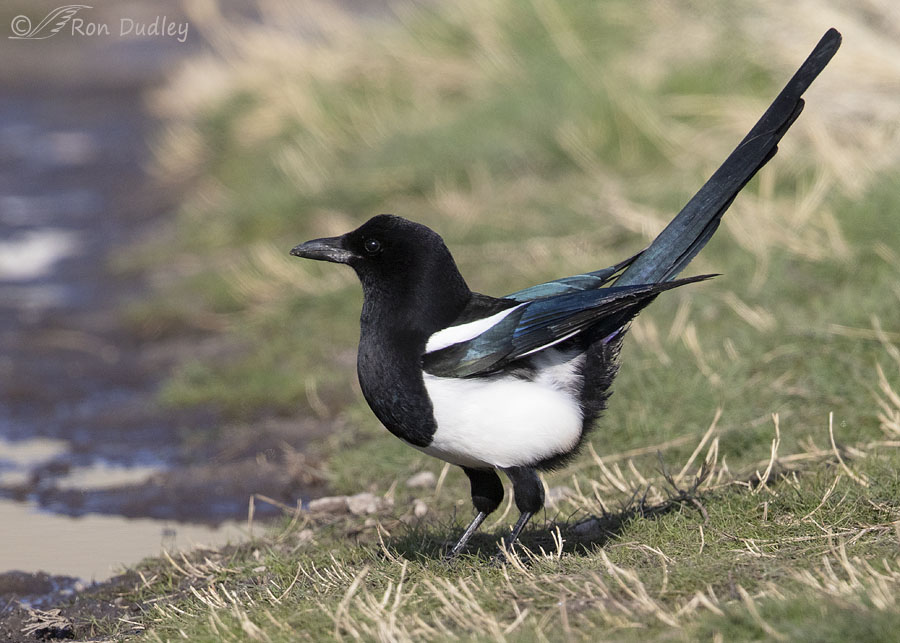
The puddle to the left in this photo seemed to be their primary source of mud. They would land next to it…
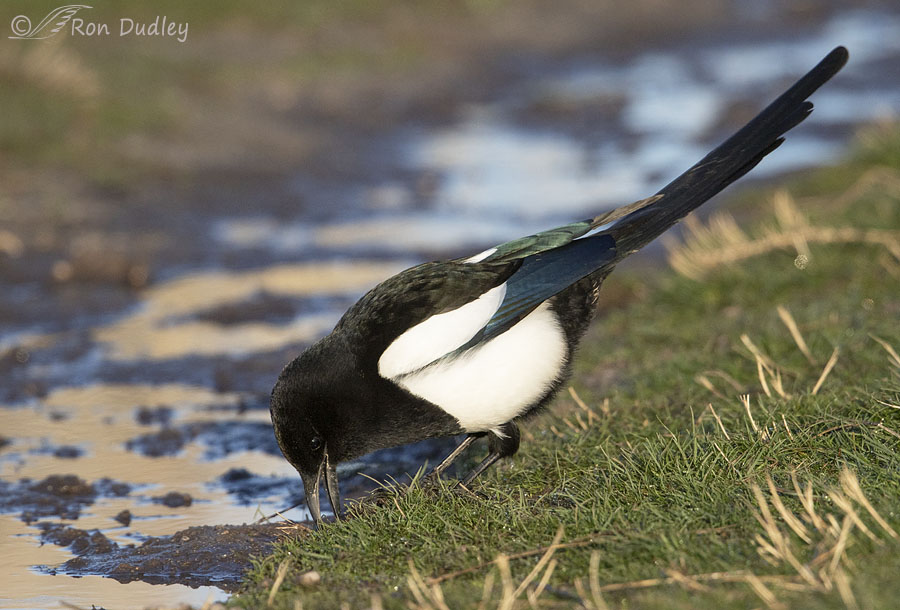
and then begin gathering mud, typically retrieving it from several locations near the puddle before they had a “full load”.
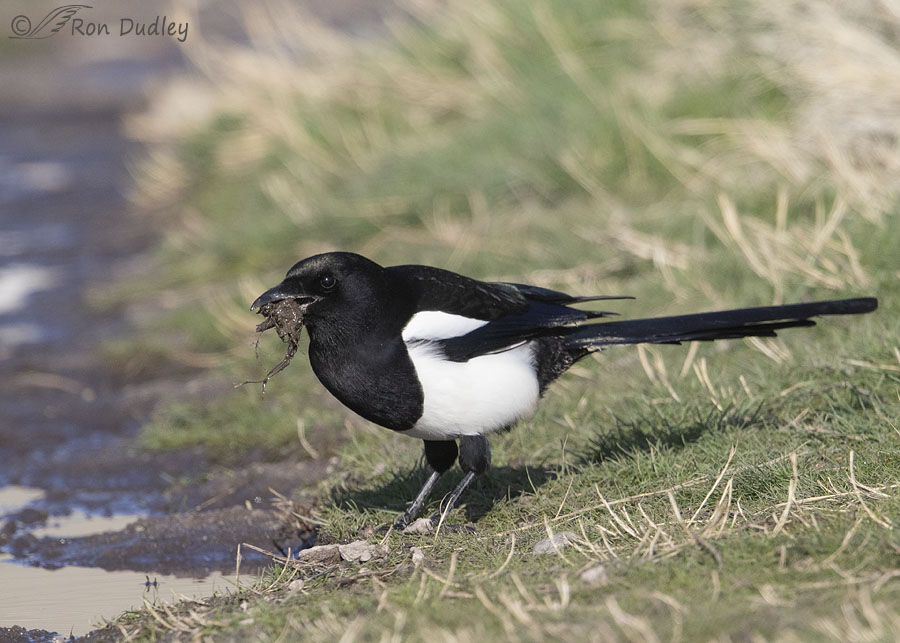
Individual loads might consist of pure mud or a mixture of mud and wet grass as we see here (like the adobe used in human construction a mixture of mud and vegetation dries to a stronger material than pure mud). I took many photos of the mud gathering process but I won’t include any more of them because these two illustrate the behavior as well as any. None of them are great shots but I was happy to finally document the behavior up close.
On an unrelated note I thought local readers in particular might be interested to know that Long-billed Curlews have finally arrived on the island.
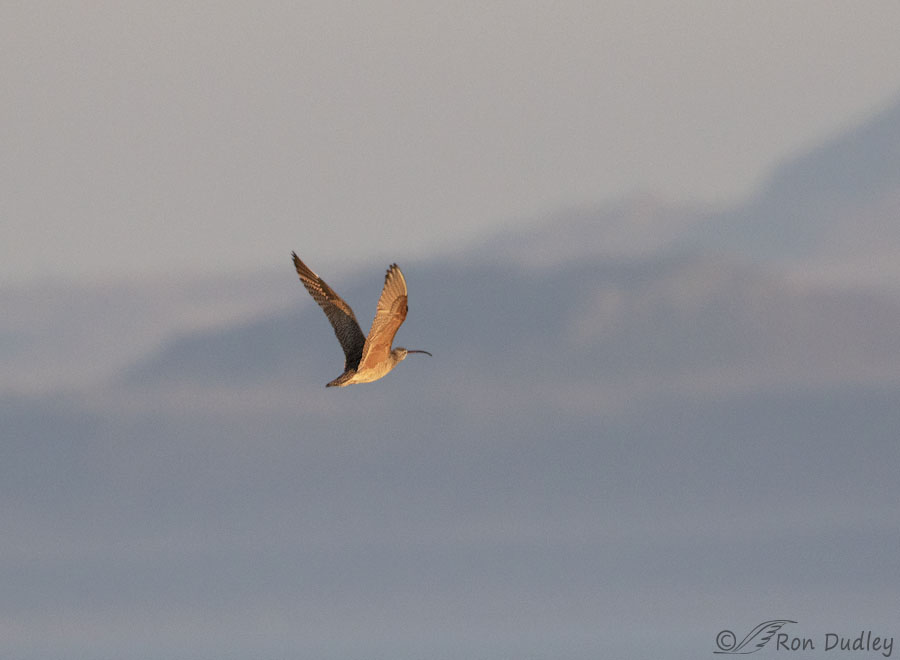
Every year I anxiously await their arrival but this year they seem to be just a little bit late. As I arrived on the island right at dawn yesterday curlews seemed to be almost everywhere based on their calls in the air and on the ground.
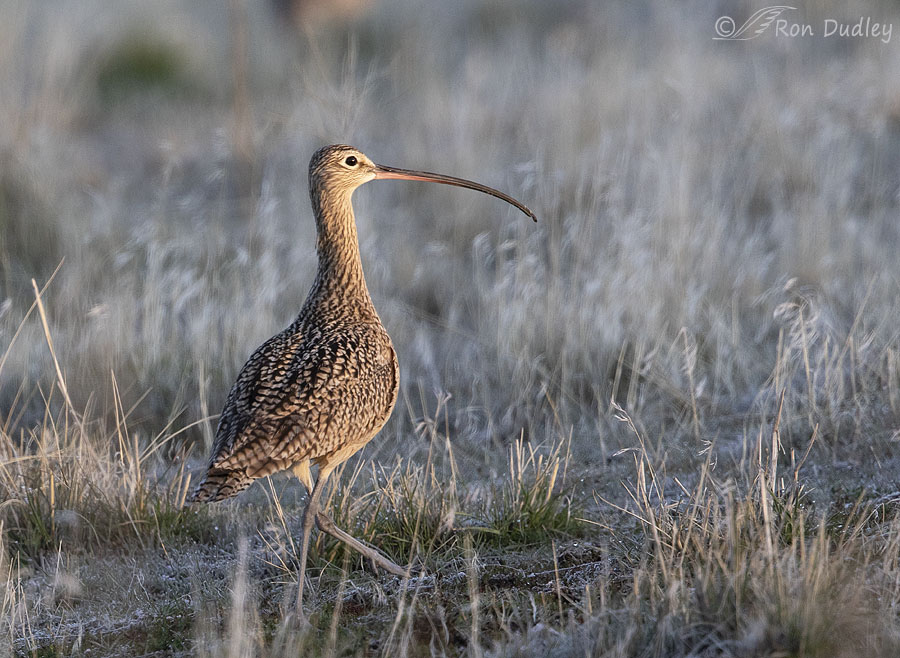
They’re still pretty skittish and mostly stay away from the roads so this mediocre shot was about the best I could manage but it does document their presence. Notice part of another curlew directly above the head of this bird.
Curlews nest on the island in spring and soon after their youngsters fledge many of them feed along the causeway for weeks. As a photographer and bird lover I look forward to those opportunities. Hopefully I’ll be able to get better shots than this one which isn’t particularly sharp.
Ron
PS – I posted earlier than usual this morning and I’m not happy about it. Yesterday I used my large and very noisy air compressor (in my garage directly below my bedroom) to top of the air pressure in my camping trailer tires because I have to take it in for service today. Well that compressor has a slow air leak and I forgot to unplug it when I was finished yesterday so that monster fired up again at 2:55 this morning and damn near shook me out of bed.
By the time I got the compressor unplugged and everything else ship-shape (it’s a long story) I was wide awake and pissed off at myself so I’ve been up since 2:55. It’s going to be a long day. I think a nap (or two) is in order so I may be sporadic in responding to any comments..


Ron, hopefully I am not interrupting your nap!!! I just had mine and it was wonderful.
Magpies are great to look at almost all of the time. I recall that you thought it was funny that our Magpies love to chase the neighbor’s cat. It is fine with me because the cat is trying to kill a bird. The cat slithers away in shame every time!!!
Glad to hear you might be getting out in your new trailer. Let the good times roll………Thanks, Ron for mud photos
I did finally get some sleep, Alice. Felt good but now most of the day is gone. Thank you.
I love following your daily entries…..very educational and entertaining, not to mention such technical skill! I hope to visit Antelope Island in the near future.
As a relative beginner, I am always trying to get tack sharp focus on birds that apparently are too far away. I have had a lot of opportunities to capture Sandhill Cranes, here at Cosumnes River Preserve. They typically may be somewhat close to the road, but soon ooze away. Now I am on to the next season, the Great White Egret rookery….nests high and at a pretty steep angle from my position. I appreciate your noting your camera settings, but I’m not sure exactly how close you are to the birds. Your curlew is fabulous! He seems to be right next to your truck. Would it be possible to share your distance from the birds, along with your camera settings? Thank you very much for your generosity in sharing your knowledge. I believe as retired teachers, it may be in our genes. lol
I hope you do get to see the island sometime, Jacquie. It can be pretty special.
I’m afraid distance from subject is too hard to figure out.
Mediocre? I think the shot is great. Picky picky hehe. It is always so much fun watching birds as they get their nests ready. We have a bird box (nest) that you can see from our back window. Today the female Sparrow is in it, calling her mate off and on. The White Crown Sparrows have been singing all day. Sadly, they will be leaving soon.
Jean, that shot is a little soft but I do like it otherwise. Thanks.
As coincidence would have it, a friend who lives in the Reno area just had her first view of magpies, and was raving ( on the phone ) about their beauty, so I forwarded today’s post to her.
I discovered the existence of your blog 3 or 4 years ago when I was researching magpie imagery and physiology–feathers, specifically–for a painting …….I guess that’s how I fell over
“Feathered Photography”, and Have been addicted to your blog ever since !
Well however it happened I’m glad you found us, Kris. You’ve been a valuable contributor for a long time.
These are wonderful shots. I really like the Curlew in flight. And that looks like quite a mouthful!
I hear you on the sleepus interruptus last night. No air compressor here, but mama dog needed to go out a couple times and let me know. And puppy is a screamer for attention (good thing she’s cute — although I’m working on training a “quiet” command). I have the dentist this morning, but then a nap — or three — is definitely in order.
Thanks, Marty. Here’s the irony. I’m so tired I’m a zombie but I just tried to nap and I can’t sleep.
I hate that too tired to sleep feeling. The gallon of coffee might have to wear off. Sometimes an audiobook (A Christmas Carol works well for me) or a YouTube documentary will put me out.
I love this series. It is always interesting to study behavior.
I think so too. Thanks, Betty.
Awesome shots of both birds. I would have been proud to have taken them!
Thanks, Joanne.
Beautiful and informative as usual, Ron. Thank you for your daily post even over hardships.
Thank you, April.
Ron,really appreciate that you take time off from those Nat Geo worthy photos to give us an educational series from time to time. Have never seen any birds other than swallows gathering mud for nest construction. Very interesting post. Hope you get a nap or two in later today.
Everett Sanborn, Prescott AZ
Thanks, Everett. I think a “nap or two” is guaranteed. I’m fading fast, despite a half gallon of coffee consumed…
I’ve never seen the Magpies gathering mud either tho know they do – reminds me of swallows doing the same thing.. Curlews! I LOVE Curlews! Glad they’re showing up in good numbers……

 I can laugh at the compressor only because I KNOW how noisy they are and ours is a ways from the house!
I can laugh at the compressor only because I KNOW how noisy they are and ours is a ways from the house!  Naps are a good thing!
Naps are a good thing! 
I figured you’d get that compressor thing, Judy. Mine is one of the noisiest compressors I’ve ever heard and I’ve heard a few.
WOW, wow, wow, Ron – what an enlightening behavioral series of the Magpies – so interesting. I’m glad you are willing to post photos that don’t meet your standards to allow us to see bird behaviors!! To me the photos are still wonderful. Their nest is amazing & large!! Do they come back to the same nest each year like some birds do?!! Now I’ll probably never see a Magpie much less the nest & the behaviors for building it – so special! Now for your unscheduled “wake-up call”!! You must have thought a bomb went off. Hearing that you are taking the camper in for service leads me to believe a trip is being planned – can’t wait to see what photos the trip will bring – unless I’m wrong?!!
Jo Ann, Magpies often use a nest from year to year but I’m never sure if it’s the same birds or not.
Yes, I’m hoping to get in a short “shake-down cruise” with the new camping trailer soon.
A good photo of the Curlew with the sun high-lighting it so nicely. Must have been an early morning shot with the ground looking darker in the bottom of the photo. I really like the whole photo, especially the touches of green in it. An interesting addition to the lives of magpies and photos with the mud gathering as a bonus. Fascinating how they know where to find the correct mud for the nest sometimes flying quite the distances from it for the source. I’ve parked and watched swallows building theirs. There is one particular spot at a bend in the marsh road that must have a different type of soils mixed together and it fits the bill for them…(no pun intended here). It is the only place Iv’e seen them getting it for the past four years. An entire flock will sometimes gather there, flying in and scooping mud and off again…never challenging each other.
Yes, it was early morning, Kathy. Light reached the curlew only seconds before that shot was taken.
I enjoy photographing the mud-gathering activities of swallows too. For me at least those shots are much easier to get than the same behavior in magpies.
The magpies are fascinating creatures. And, I apologize, but the air compressor story made me belly laugh this morning.
It’ll be a while before I can laugh about it, Arwen. I’ll need to catch up on my sleep first…
Curlews and Magpies, oh my!!!! Thanks again for a beautiful start to the day.
Willets and mockingbirds shouldn’t be far behind, Diane. And yesterday we noticed more Sage Thrashers too. The island is finally beginning to pick up.